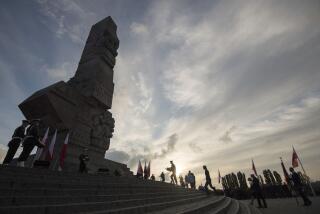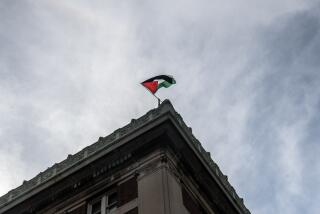Poland’s Auschwitz Museum Leaves a Haunting Impression on Visitors
- Share via
AUSCHWITZ, Poland — Most travel guides to Eastern Europe don’t detail what was once Nazi Germany’s largest concentration and extermination camp.
Fodor’s ’89 guidebook gives it a scant six lines.
Yet in all the world, few sites are as moving--and as hauntingly memorable--as the state museum of Auschwitz-Birkenau.
Some people will, understandably, be offended at the thought of tourists wandering the death camp’s bleak, blood-stained grounds.
But there are reasons to come to a place like this. Judging from the many flowers, lighted candles and small Israeli flags placed at various camp locations--especially inside the crematory and against what is called the Wall of Death--many come to pay homage to those who suffered and died.
Some also come for the historical significance--which is heightened as the world observes the 50th anniversary this year of the start of World War II.
Some stop by simply out of curiosity, to see for themselves. In recent weeks, headlines have chronicled the controversy that surrounds the presence of a Roman Catholic convent at the Auschwitz death camp.
To the Jews it is a desecration of a place that is an enduring emblem of the Holocaust. Poles, who are predominantly Roman Catholic, argue that Auschwitz is also a national memorial to their wartime scars. Whatever the outcome, the dispute may never be resolved emotionally.
Four million people representing 24 countries were murdered at the former Konzentrationslager Auschwitz and the neighboring camp of Birkenau. Of that number, 2.5 million were Jews.
In April, 1940, Germany issued the orders to establish a camp at the outskirts of the sleepy village of Oswiecim, which the Germans called Auschwitz, 35 miles west of Kracow. On June 14 of that year the first prisoners--728 Poles--arrived at Auschwitz, also known as the mother camp, or Auschwitz I.
But Auschwitz proved too small to accommodate Hitler’s plans for the “final solution.” So Birkenau--sometimes known as Auschwitz II and by its Polish name, Brzezinka, was established.
Physically, the two camps are quite different. Auschwitz is small and orderly, comprised of 28 two- and three-story brick buildings (eight of them built by prisoners), a gas chamber and a crematory.
Birkenau, in contrast, is overwhelming in size. Comprised of 10 square miles surrounded by double barbed-wire fences, it is the site of the International Monument to the Victims of Fascism. Built in 1967, the monument is at the platform where the trains arrived and the deportees disembarked and found themselves subjected to selektion (“selection,” which meant extermination).
From the steps of the monument a visitor can see wooden barracks in the distance (built to hold 48 horses, they each ultimately held 800 people), and the remains of crematories. And fields that stretch as far as the eye can see.
Bone fragments can still be found in the fields of Birkenau.
No history book, or even personal memoir, can approximate a visit to Auschwitz-Birkenau. In no other way can someone who wasn’t here-- then --get a sense of the enormity of what happened. At the Auschwitz museum headquarters a film details the camp’s history, atrocities and liberation (by the Soviets on Jan. 22, 1945). It’s short, but the images are lasting, including the sequence in which a group of liberated children--some in striped uniforms, many with confused faces--cluster before the news cameras and, en masse, hold out their tattooed arms.
It’s an eerie feeling to tour the camp after the movie--like walking through a newsreel. For most of it remains just as it was--right down to signs that are still posted on the barbed-wire fences.
Go through the infamous Auschwitz camp entrance, with its cynical proclamation, “Arbeit Macht Frei” (Work Makes You Free), and you find yourself on the same paths where prisoners marched.
The cell blocks now hold exhibits that detail the rise of National Socialism . . . and the results.
Nowhere are those results more evident than in the block where victims’ belongings--retrieved from warehouses at Birkenau--are on display.
There’s a room with an endless pile of adults’ shoes of every size, shape and color, that literally spans the length of the room. You’ll find children’s shoes in the next room. And a mountain of spectacles.
There are utensils and pots and pans. And suitcases--most of which bear the handwritten names and addresses of their owners, who obviously worried about losing their possessions during their “relocation.”
Also on view: a tin container of Cyclon B, which has been opened to show the little blue pellets.
It was in Cell Block 11--the prison that existed within Auschwitz--that the Nazis first experimented with the lethal gas. The first subjects: 600 Soviet POWs and 250 patients from the camp hospital.
Adjacent to this building is the Wall of Death where 20,000 executions took place. Medical experiments were carried out in the next building over (Cell Block 10), which is not open to the public.
But visitors can go inside the bunkerlike enclosure that houses the gas chamber and crematory. This facility, dismantled by the Nazis in 1943, was rebuilt and houses the original furnaces and body carts.
Just outside the enclosure is a gallows. There, in 1949, the Poles hanged the camp’s commandant.
From Auschwitz it’s a brief drive to the sprawling Birkenau, where visitors must walk (cars are not allowed) down a long path that leads to the monument.
Once a death factory, Birkenau had four crematories. The crematories couldn’t keep up with the gas chambers, so bodies were also burned on pyres and in open pits.
To really explore Birkenau means venturing beyond the monument--going inside the barracks, up to the crematories and walking one of the paths that lead into the distance of the camp.
We came upon a large, curious building at one edge of the camp, which was called the “sauna.” This building, which is on boggy ground, wasn’t officially open, but was accessible through one of several broken windows.
Inside the sauna you can retrace the prisoners’ steps. They entered wearing civilian garb, were deloused, showered, shaved, given uniforms and then sent to roll call.
Birkenau is such a somber setting that it was surreal--and startling--to see local children taking shortcuts across the camp, some of them on bicycles. But of course, life continues in the village of Oswiecim.
In fact, children of museum workers play outside brick apartments just outside one of the Auschwitz gates (within view of the gas chamber/crematory).
An estimated 600,000 persons from 83 countries visit Auschwitz-Birkenau annually. Of that number, 70% are from Poland. It is common to see troops of Polish schoolchildren being led across the grounds by their teachers.
The state museum at Auschwitz-Birkenau is open all year. Admission is free, although there are modest fees for the movie and guide services. Arrangements should be made in advance for tours because there are few English-speaking guides. But by no means is it necessary to see Auschwitz-Birkenau with a guide.
An excellent pocket-size guidebook to the museum is available in one of the museum’s several shops. The stock consists almost entirely of books about the camp and the Warsaw Ghetto. There is also a handful of post cards--some of which feature camp illustrations by former inmates.
Auschwitz-Birkenau is on the route that links the cities of Warsaw and Kracow. But it should not be sandwiched into a day’s trip between the two points. Visitors should spend at least a full day, two if at all possible.
For accommodations, try one of the Orbis hotels in the coal-mining town of Katowice less than 30 minutes from the camp. There is also a highly recommended Holiday Inn in Kracow, where they’ll make arrangements for your camp tour.
For more information on travel to Poland, contact the Orbis Polish Travel Bureau, 500 Fifth Ave., New York 10110, (212) 391-0844.
More to Read
Sign up for The Wild
We’ll help you find the best places to hike, bike and run, as well as the perfect silent spots for meditation and yoga.
You may occasionally receive promotional content from the Los Angeles Times.






